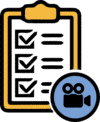Knowledge Management Strategy
A knowledge management strategy is a set of steps taken to ensure that data, information, and knowledge are more effectively used. This ensures that a project or program performs better, and that results and impacts are better. Therefore, the goal of knowledge management plans and strategies is to facilitate the generation, sharing, and use of knowledge within a project or program. It facilitates policy engagement, new partnerships, scaling up, and higher-quality performance and results. Moreover, it is expected to help raise the visibility of results and impacts across the various stakeholders involved.
Knowledge management needs to be seen as a participatory process, with organizations and individuals working together, sharing responsibilities, and with opportunities for all of them to exchange ideas and opinions, and to learn from each other. It must include capacity development initiatives, with a training element which helps team members and beneficiaries participate and to benefit from the program. It must be built around learning, and on using the lessons drawn to scaling up initiatives and impact–paying attention to thefactors that may influence adoption, and taking concrete steps to promote it.
During each of the three phases of MEV-CAM (knowledge generation, knowledge monitoring, and knowledge sharing), strategically timed interventions and events will take place.
While these phases seem linear, it is crucial to note that they are interconnected. The steps and activities in one phase contribute to those in the next one, and the latter benefit directly from the results seen at the beginning. It is equally critical to emphasise that these will overlap and run in parallel at times.
Knowledge Generation

Together with an initial planning process, the first phase highlights the need to collect information and document the point of departure: the specific challenges and needs in the field, and the perspectives of those living there. This includes the collection of information on those activities already going on in the different countries, as those working to address a negative situation. A third part, as one that will roll out throughout the implementation of the whole initiative, includes the development of a training program.
Knowledge Monitoring

Having identified the main challenges in the field and ongoing initiatives to address them, and from which the different teams will draw key lessons, the next phase starts by identifying what type of information is needed and where it is possible to find it, and then collecting in different ways. The information collected needs to be organized in one way or another, helping team members see what information is there, and then helping them describe an initiative in detail, analyze it and draw lessons and recommendations that can then be shared with others.
Knowledge Sharing

A third phase needs to focus on the presentation and dissemination of the lessons learnt; reaching others - and then working so that these others are able to adopt these lessons, start following them, and scale up the results originally seen (taking into account that these are not activities that only start here: these are phases that will overlap with each other). The dissemination of the main observations and lessons learnt includes steps that consider advocacy and the promotion of change in terms of practices and behavior. This generally considers the completion of a communications strategy that helps identify the target audience (as those expected to adopt an idea) and the selection of the products and channels that help reach these audiences and share information with them.
Its main interest is to strengthen local capacities for participatory monitoring and knowledge management, and to facilitate a process through which the different teams will be able to learn from each other, in a way that leads to better results and scaling up. This will take the advantage of the Committee on Forestry Working Group on Dryland Forests and Agrosilvopastoral Systems (COFO WG) and of its members in different dryland regions, and of their capacity to play a major role in a process that helps scale the impacts of the program beyond the borders of the eleven countries where it will be starting.
The participatory video approach becomes more interactive, dynamic and powerful monitoring tool for management and communities, providing a continuous view of project progress. It also touches upon and defines the means of documenting the possible changes within the local community, government and stakeholders, social and traditional norms and most importantly the change occurring with dryland management and degradation that occurs during the projects lifetime.

